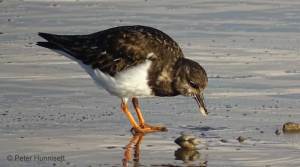Bulverhythe Beach

This part of the Combe Valley Countryside Park is an area of vegetated shingle backed, at the western end, by low sandstone cliffs. It has been designated an SNCI (Site of Nature Conservation Interest) due to its ecological and geomorphological importance. Although fairly common in parts of Britain, vegetated shingle is a globally rare and threatened habitat.
Vegetated shingle occurs on relatively stable beaches where there is a flow of fresh water through the shingle, sufficient to support the plants that are hardy enough to grow in this harsh environment. Shingle vegetation also increases the stability of beaches and limits sedimentary movement, helping to protect our homes, businesses and other environmental interests from flooding and coastal erosion.
Other important features include the wreck of the Amsterdam (designated and protected under the Protection of Wrecks Act, 1973), as well as remnants of a submerged prehistoric forest, both of which can be seen at low tide.

The area supports a range of shingle plants including:
Orache Atriplex spp.,
Sea Beet Beta vulgaris
Sea-kale Crambe maritima,
Bittersweet Solanum dulcamara,
Stonecrop Sedum spp.,
Yellow Horned-poppy Glaucium flavum,
Curled Dock Rumex crispus ssp. littoreus,
Buck’s-horn Plantain Plantago coronopus,
Sticky Groundsel Senecio viscosus,
Tree Mallow Lavatera arborea,
Sea Radish Raphanus raphanistrum ssp. maritimus,
mosses and grasses, crustose, foliose and fruiticose lichens.
Other species found at the site include Common Ragwort Senecio jacobaea, and Brambles Rubus spp.
Note that Bittersweet, also known as Woody Nightshade, has red berries that are highly poisonous.

Flocks of Turnstones can often be seen, sometimes accompanied by Purple Sandpipers.
The sandstone cliffs are home to solitary bees and wasps in springtime and you can also find the Green Tiger Beetle.
Galley hill is a good vantage point from which seals can sometimes be spotted. If you are really lucky you may also see a Harbour Porpoise or Bottlenose Dolphin.

